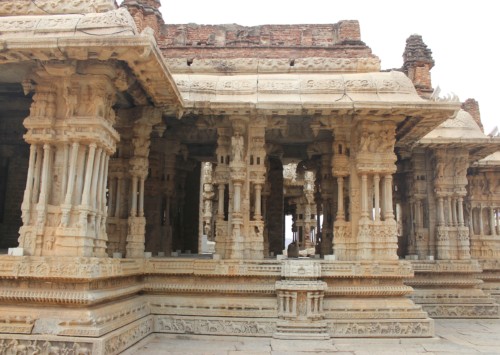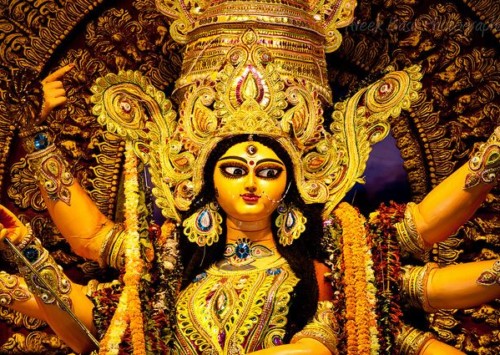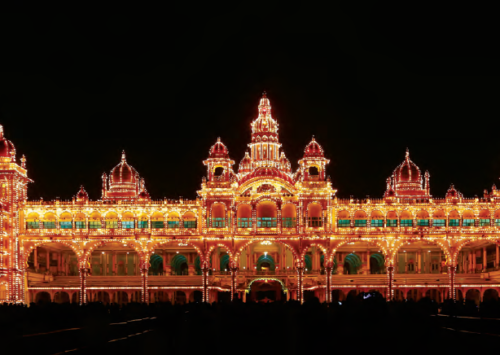Nadahabba: Celebrating extravagant Mysuru Dasara

This year Mysuru Dasara marks 411 years since Mysuru started celebrating Dasara in the royal manner (MIG photos)
The 10-day long Mysuru Dasara, that normally falls in the month of September or October as per the Hindu calendar, is celebrated in a distinct and unique manner. Though the entire city, which is the second largest city in Karnataka and home to the erstwhile royal family of Wodeyars, is lit up and beautifully decorated on the occasion, the Mysore Palace lies at the centre of the celebrations.
The first six days of the festival honour Saraswati, the Hindu deity of knowledge and fine arts, while the seventh and eighth days are reserved for Durga, the goddess of valour and the ninth day is to honour goddess of wealth, Laxmi.
During these days, various scenes from various stories in various Hindu epics and puranas are recounted using kolu or figurines. On the tenth day, the grand finale is marked by a spectacular procession that starts from the Mysore Palace.
“In all homes in Karnataka, the kolu is displayed in various themes, the small dolls are decorated and adorned with garlands. The whole puja (prayer) room is filled with lots of dolls. Also, each day during these nine days a new delicacy is offered to the goddess and distributed to children,” Shobha Shri from Bengaluru, capital of Karnataka, tells Media India Group.
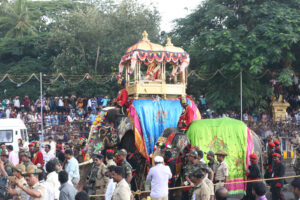
Caparisoned elephants carry an idol of Goddess Chamundeshwari, placed in the howdah made of 750 kg pure gold (Photo: Skyway International Travels)
But the main celebrations occur in the neighbouring city of Mysuru which is about 150 km away and has been the home to royal family of Wodeyars who ruled over Mysore for several centuries. Like in other places, Mysore Dasara is celebrated to mark the victory of good over the evil as the popular belief is that Goddess Chamundeshwari, a form of Durga, killed the demon king Mahisasura on Vijayadashami.
The celebrations in Mysore originated in the 14th century, when the Kings of the Vijayanagara Empire, one of the most prominent empires of peninsular India, started the practice of celebrating it with a massive procession with elephants, musicians and dancers that perform various cultural and folk arts on the streets of the city. This tradition has continued over the centuries and Mysore Dasara became to be known as the state festival of Karnataka. This year marks 411 years since Mysuru started celebrating Dasara in the royal manner. The highlight of the celebration has been the royal procession of caparisoned elephants with the king seated in a golden howdah, a throne with a canopy, made of 750 kg pure gold, and followed by his ministers and royal staff and his army. However, nowadays, instead of the descendants of the royal family, an idol of Goddess Chamundeshwari is placed in the howdah and is the centre of attraction of the procession.
As it is celebrated with great pomp and enthusiasm, it attracts visitors from many parts of India as well as from overseas.
“On the occasion, everyone decorates their homes with lamps and flowers to celebrate it in a traditional way. While relatives come home and participates in story narration activities, we wait for the whole year to celebrate this festival,” says Sudha Rammoorthy.
Sheen of festivities
The Mysore Palace is lit up during this period with thousands of bulbs and flowers and there is a carnival atmosphere across the city, and the city transforms into a hub of celebrations. The celebration starts from the “Jamboo Savari” is the grand famous procession starts its celebration in front of the Mysore Palace, involves decorated elephant parades, procession of dancers and musicians escorting an idol of goddess Chamundeswari mounted on a golden hawda (throne) atop an elephant is carried through the city.
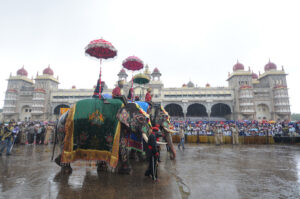
Jamboo Savari is the grand procession that starts from the Mysore Palace on the 10th day (Photo: Skyway International Travels)
The Jumboo Savari starts from the Mysore Palace and culminates at a place called Bannimantap nearly 4km away from the Palace. Soldiers and artist across the state performs various stunts on the streets including Colourful tableaux, dance groups, music bands, horses and camels form a part of the procession.
“The idol is worshipped by the royal couple and Governor of the Karnataka garlands the idol before it is taken around in the procession. During this grand festival, the road from the Mysore Palace to Bannimantap is fully crowded from both the sides, many tourists from different states even from abroad participate in this festival. The whole city is decorated with the huge bright lights which gives a grand and royal look to the city during Nadahabba festival. This festival is very close to our hearts,” says Manu Mahalingaiah, director of Skyway International Travels, the largest tour operator based in Karnataka.
After the procession, also called Jamboo Savari, a torchlight parade is the other major attraction that takes place in the evening at the Bannimantap Parade grounds.
Mahalingaiah has been participating in Mysuru Dasara festival for almost 30 years. “Nearly 10-15 elephants come two months before the festival and they are trained for the parade. During the procession, the entire stretch is well monitored and protected by the police to ensure no accidents happen. The government plays a major role in organising this festival,” he says.
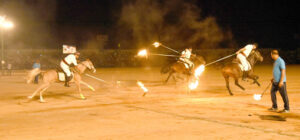
Torchlight parade is another major attraction that takes place in the evening at the Bannimantap Parade grounds (Photo: Skyway International Travels)
The parade also includes a show and a feat of acrobatics on motorbikes stunts, in the same way as it is done during the Republic Day celebrations on January 26 and the event comes to an end with the playing of the national anthem of the erstwhile Mysore State by the military band and by bursting fire crackers.
The 10-day festival showcases the grandeur and majesty of the erstwhile rulers and offers the people a glimpse into the history of the state, says Mahalingaiah.

